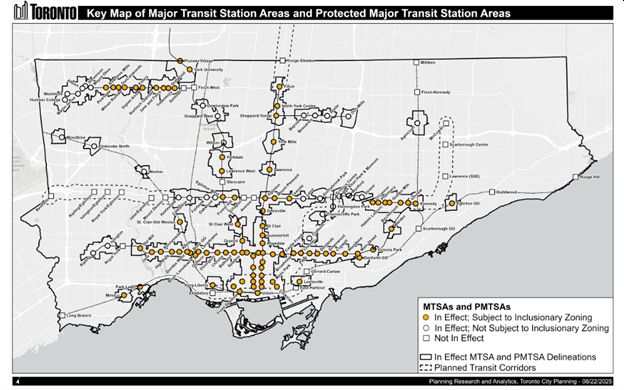- within Real Estate and Construction topic(s)
- in United States
- with Finance and Tax Executives
- with readers working within the Healthcare and Property industries
On August 15, 2025, the Minister of Municipal Affairs and Housing (the Minister) approved City of Toronto Official Plan Amendment (OPA) 524, OPA 537, OPA 540, OPA 544 and OPA 570 (collectively, the OPAs), with modifications.
The OPAs, which are now in force and are not subject to appeal, will have significant implications on the development of housing in proximity to transit stations in the City of Toronto (the City). They establish the boundaries of 25 major transit station areas (MTSAs) and 95 protected major transit station areas (PMTSAs) across the City and create associated policies which govern the allocation of growth, density and building heights within the MTSAs/PMTSAs. In addition, the OPAs bring into effect the City's Inclusionary Zoning By-law No. 941-2021 (the IZ By-law) in certain PMTSAs, meaning that certain development applications within those PMTSAs must provide a prescribed percentage of affordable housing, subject to the transition provisions in the IZ By-law. As further explained below, the IZ By-law has not been updated to reflect Ontario Regulation 54/25 (O. Reg. 54/25), which restricts the maximum set-aside rates and affordability period to 5% and 25 years, respectively, whereas the IZ By-law currently imposes a set-aside rate of 10% and an affordability period of 99 years.
This bulletin provides an overview of the key policy changes implemented through the OPAs and the potential impacts on land use planning and development in the City.
Overview of the OPAs
The OPAs approved by the Minister establish the locations and boundaries of MTSAs and PMTSAs across the City. Specifically:
- OPA 524 establishes 16 PMTSAs in Downtown Toronto;
- OPA 537 implements the Keele-St. Clair Secondary Plan, delineating and setting minimum density targets for a new PMTSA around the St. Clair-Old Weston transit hub;
- OPA 540 establishes 23 PMTSAs along the Bloor-Danforth subway corridor;
- OPA 544 establishes six PMTSAs and three MTSAs in Etobicoke and North York, with the Minister modifying the boundaries of the York Mills PMTSA;
- OPA 570 establishes 49 PMTSAs city‑wide, with modifications to minimum density maps for eight areas, including, Birchmount, Golden Mile, and Islington; and
- OPA 575 establishes 22 MTSAs along the Eglinton Crosstown LRT corridor, with one map adjustment to the Agincourt MTSA.
The Minister did not issue a decision with respect to ten PMTSAs and four MTSAs which were previously adopted by Council, being East Harbour, Exhibition, Scarborough Centre, Gerrard-Carlaw, Yonge-Steeles, Rouge Hill, Milliken, Don Valley (Science Centre), Long Branch, Scarborough GO, Guildwood GO, Finch West and Sentinel.
The Planning Research and Analytics branch of the City's Planning Department prepared the Key Map below. It sets out the locations and boundaries of the approved MTSAs and PMTSAs and also indicates whether each PMTSA is subject to the IZ By-law:

Key policies introduced through the modified OPAs
In addition to establishing the locations and boundaries for MTSAs and PMTSAs, the OPAs, as modified by the Minister, create associated policies which govern growth, density, building heights and land use designations in each MTSA and PMTSA. Specifically, the Minister modified OPA 540 to include a new Chapter 8 to the Official Plan, which creates a "framework to facilitate transit-supportive development through the delineation of [MTSAs] and [PMTSAs] across the City." These modifications reflect the Province's emphasis on allocating and planning for growth and density on lands that are proximate to transit stations.
Key policies implemented through the OPAs include:
- Allocation of growth and density
The Minister's modifications introduce a policy which explicitly states that growth should be directed to "delineated [MTSAs] and [PMTSAs]," in addition to Centres, Avenues, Employment Areas and the Downtown.
The Minister's modifications also direct the City to review the policies in Chapter 8 and the associated minimum density targets "as part of its regular Official Plan review or as part of local infrastructure reviews" to ensure that growth is appropriately planned for and managed and that complete communities are created with the necessary infrastructure.
- New density permissions
The Minister's modifications provide that lands within an MTSA/PMTSA that are designated Apartment Neighbourhoods, Mixed Use Areas or Regeneration Areas, must permit a floor space index (FSI) of:
- FSI of eight or more on lands within 200 metres of a transit station; and
- FSI of six or more on lands within 200-500 metres of a transit station.
- As-of-right heights for sites that can accommodate
three or more towers
The Minister's modifications require the City to permit specified as-of-right building heights on sites that "can accommodate three or more towers" in MTSAs and PMTSAs and within areas designated Apartment Neighborhoods, Mixed Use Areas and Regeneration Areas. Specifically:
- Up to 30 storeys are permitted for lands within 200 metres of a transit station;
- Up to 20 storeys are permitted for lands within 200-500 metres of a transit station; and
- Additional building heights are permitted without an amendment to the Official Plan "if a block context plan is provided demonstrating elements such as new public streets, new parks, publicly accessible open spaces, mid-block connections, public art, and a mix of building types and heights."
The policy does not provide any further guidance or criteria to determine whether a site "can accommodate three or more towers," which could lead to future disputes between developers and the City.
- Height permissions for Neighbourhoods
The Minister's modifications provide that multiplexes and apartments are permitted on lands designated Neighbourhoods within an MTSA or PMTSA, without an amendment to the Official Plan, with the following heights:- Up to four storeys;
- Up to six storeys within 200 metres of an existing or planned transit station; and
- Up to six storeys with frontage on a major street shown on Map 3.
- Special Policy Areas
The Minister's modifications include policies that will apply to "Special Policy Areas" as delineated on Map 1 for each applicable MTSA and Map 2 for each applicable PMTSA. The policies that apply to "Special Policy Areas" establish a minimum development density and require approvals from the Minister and the Minister of Natural Resources for any future development permissions. These policies appear to be aimed at protecting certain natural heritage features in the City from the impacts of development.
What does this mean for Inclusionary Zoning in the City of Toronto?
The Minister's decision brings the Inclusionary Zoning (IZ) By-law into effect in certain PMTSAs across the City, meaning that certain development applications will be required to provide affordable housing, in accordance with the IZ By-law.
Subsections 16(4)-(13) of the Planning Act permit municipalities to implement a land use planning tool referred to as "Inclusionary Zoning" (IZ). This tool permits a municipality to require developers to provide a prescribed percentage of affordable housing units within new residential developments located in delineated and Minister-approved PMTSAs.
In November 2021, Toronto City Council adopted its IZ framework under the Planning Act through OPA 557 and the IZ By-law, which requires that certain residential developments within designated IZ Market Areas and approved PMTSAs include set aside rates of up to 10% for affordable units and affordability periods of 99 years. The transition provisions in the IZ By-law provide that those projects with complete applications for a zoning by-law amendment and site plan approval, site plan approval, minor variance or application for a building permit filed on or prior to the Minister's approval of PMTSAs (being August 15, 2025) are not subject to the affordable housing requirements. Similarly, projects where a zoning by-law amendment came into force prior to the passing of a Community Benefits Charge by-law and an agreement was executed in accordance with section 37 of the Planning Act on or prior to the Minister's approval of PMTSAs are also exempt. Now that the Minister has approved PMTSAs in the City, the City's IZ By-law is in full effect, unless the development is exempt by virtue of the transition provisions.
It is important to note that the IZ By-law has not been updated to reflect O. Reg. 54/25, which was enacted by the Province on May 12, 2025. O. Reg. 54/25 amends Ontario's IZ Regulation, Ontario Regulation 232/18, by capping the amount of affordable housing that a municipality can require at 5% of a development's residential gross floor area or unit count, with a maximum affordability period of 25 years. As such, despite the IZ By-law requiring maximum set aside rates and affordability periods of 10% and 99 years respectively, the City is restricted to the provincial caps of 5% and 25 years established under O. Reg. 54/25.
Next steps for City Council and for developers/landowners
City Council is required to amend its Zoning By-law to bring it into conformity with the OPAs. Among other things, zoning standards pertaining to heights and densities as outlined in the OPAs will need to be amended. In the meantime, developers and landowners within MTSAs and PMTSAs should be aware of increased permissions for height and density when preparing to file development applications. Lastly, developers and landowners should be aware of the requirements to provide affordable housing in certain PMTSAs under the IZ By-law, which is now in-effect.
Conclusion
The Minister's approval of and modifications to the OPAs reflect the Province's continued commitment to increasing the housing supply and allocating and planning for growth near transit. These efforts are further reflected in comments that Mayor Olivia Chow and the Minister provided to the media when announcing approval of the OPAs. When asked why the Province delayed the City's approval of transit-oriented housing plans, the Minister explained that the delay was necessary because the original 500,000 unit plan was not ambitious enough and the Province worked with the City to triple the target to 1.5 million homes to "get it right." Mayor Chow was in agreement with the Minister's comments, stating that the previous plan was insufficient, and that she worked with the Premier to create a more ambitious target that cuts red tape for builders, including the City's pilot project, which cut 100% of development charges to spur development. Mayor Chow further added that the Minister's approvals of the OPAs will include the construction of 53,000 affordable housing units.
We understand that the Building Industry and Land Development Association continues to work with the Ontario Home Builder's Association and is in conversations with the City of Toronto and the Provincial Government regarding additional clarity on the applicability of the IZ By-law.
About Dentons
Dentons is the world's first polycentric global law firm. A top 20 firm on the Acritas 2015 Global Elite Brand Index, the Firm is committed to challenging the status quo in delivering consistent and uncompromising quality and value in new and inventive ways. Driven to provide clients a competitive edge, and connected to the communities where its clients want to do business, Dentons knows that understanding local cultures is crucial to successfully completing a deal, resolving a dispute or solving a business challenge. Now the world's largest law firm, Dentons' global team builds agile, tailored solutions to meet the local, national and global needs of private and public clients of any size in more than 125 locations serving 50-plus countries. www.dentons.com
The content of this article is intended to provide a general guide to the subject matter. Specialist advice should be sought about your specific circumstances. Specific Questions relating to this article should be addressed directly to the author.





